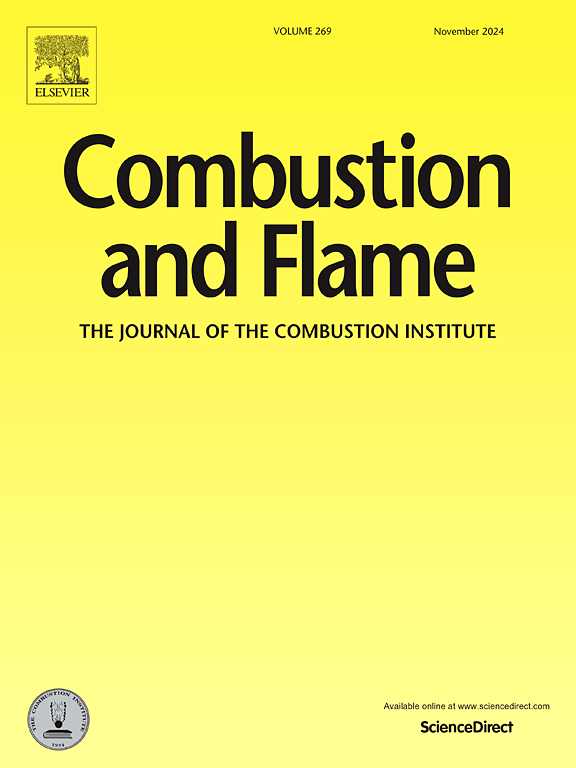Rush-to-equilibrium concept for minimizing reactive nitrogen emissions in ammonia combustion
IF 6.2
2区 工程技术
Q2 ENERGY & FUELS
引用次数: 0
Abstract
Ammonia is a zero-carbon fuel that has been receiving increasing attention for power generation and even transportation. Compared to hydrogen, ammonia’s volumetric energy density is higher, is not as explosive, and has well established transport and storage technologies. However, ammonia has poor flammability and flame stability characteristics and more reactive nitrogen emissions (nitrogen oxides, nitrous oxide) than hydrocarbon fuels, at least with traditional combustion processes. Partially cracking ammonia addresses its flammability and stability issues, through on-board catalysts or autothermal crackers, into a mixture of ammonia, hydrogen, and nitrogen. However, reactive nitrogen emissions remain a challenge, and mechanisms of their emissions are fundamentally different in ammonia and hydrocarbon combustion. While rich-quench-lean ammonia combustion strategies have shown promise, the largest contributions to reactive nitrogen emissions are the unrelaxed emissions in the fuel-rich first stage due to overshoot of thermodynamic equilibrium within the reaction zone of premixed flames coupled with finite residence times available for relaxation to equilibrium. This work introduces a rush-to-equilibrium concept for partially cracked ammonia combustion, which aims to reduce the unrelaxed reactive nitrogen emissions in finite residence times by accelerating the approach to equilibrium. In the concept, a flow particle is subjected to a decaying mixing rate as it transits the premixed flame. This plays an important role in mitigating the mixing effects that prevents the flow particle approach to equilibrium, and promoting the chemistry effects to push the particle toward equilibrium, all while considering residence times typical of gas turbines for power generation. Evaluated with a state-of-the-art combustion model at gas turbine conditions, the concept shows the potential for a reduction in reactive nitrogen emissions by an order of magnitude at even modest mixing rate decay rates. It is also shown that the concept works irrespective of cracking extent, pressure, temperature, etc. A brief discussion of practical feasibility reveals reasonable geometric and flow parameters characteristic of modern gas turbine combustors for power generation.
Novelty and Significance Statement
A novel rush-to-equilibrium combustion concept is proposed with the aim of reducing reactive nitrogen emissions, which include nitrogen oxides and nitrous oxide, from partially cracked ammonia combustion at gas turbine conditions. Reactive nitrogen emissions are elevated in partially cracked ammonia combustion systems because insufficient residence time is available to reach thermodynamic equilibrium. A concept is proposed to address this issue, leveraging decaying mixing rates, without modifying typical gas turbine for power generation residence times by accelerating the approach to thermodynamic equilibrium. The new concept is demonstrated of being capable of significantly reducing reactive nitrogen emissions (by a factor of an order of magnitude). Finally, implementation of the new concept is showed to be practically feasible.
在氨燃烧中减少活性氮排放的快速平衡概念
氨是一种零碳燃料,在发电甚至运输领域受到越来越多的关注。与氢相比,氨的体积能量密度更高,爆炸性较小,并且具有完善的运输和储存技术。然而,氨具有较差的可燃性和火焰稳定性特性,并且比碳氢化合物燃料排放更多的活性氮(氮氧化物,氧化亚氮),至少在传统的燃烧过程中是这样。通过机载催化剂或自热裂解装置,部分裂解氨解决了其可燃性和稳定性问题,将氨、氢和氮混合在一起。然而,活性氮的排放仍然是一个挑战,其排放机制在氨和碳氢化合物燃烧中有着根本的不同。虽然富淬贫氨燃烧策略已显示出前景,但对活性氮排放贡献最大的是富燃料第一阶段的未放松排放,这是由于预混火焰反应区内热力学平衡超调以及可松弛到平衡的有限停留时间造成的。这项工作引入了一个快速平衡的概念,部分裂解氨燃烧,其目的是减少不放松的活性氮排放,在有限的停留时间内加速接近平衡。在这个概念中,流动粒子在经过预混火焰时受到衰减混合速率的影响。这在减轻阻碍流动颗粒接近平衡的混合效应和促进化学效应以推动颗粒接近平衡方面起着重要作用,同时考虑到燃气轮机发电的典型停留时间。在燃气轮机条件下使用最先进的燃烧模型进行评估,该概念表明,即使在适度的混合率衰减率下,活性氮排放也有可能减少一个数量级。结果还表明,无论开裂程度、压力、温度等因素如何,该概念都有效。通过对实际可行性的简要讨论,揭示了现代燃气轮机发电燃烧室合理的几何参数和流动参数特征。摘要提出了一种新的冲平衡燃烧概念,旨在减少燃气轮机条件下部分裂解氨燃烧产生的活性氮排放,包括氮氧化物和氧化亚氮。在部分破裂的氨燃烧系统中,活性氮的排放量升高,因为没有足够的停留时间来达到热力学平衡。提出了一个概念来解决这个问题,利用衰减的混合率,而不修改典型的燃气轮机发电停留时间,通过加速接近热力学平衡。新概念被证明能够显著减少活性氮的排放(通过一个数量级的因素)。最后,证明了新概念的实施是切实可行的。
本文章由计算机程序翻译,如有差异,请以英文原文为准。
求助全文
约1分钟内获得全文
求助全文
来源期刊

Combustion and Flame
工程技术-工程:化工
CiteScore
9.50
自引率
20.50%
发文量
631
审稿时长
3.8 months
期刊介绍:
The mission of the journal is to publish high quality work from experimental, theoretical, and computational investigations on the fundamentals of combustion phenomena and closely allied matters. While submissions in all pertinent areas are welcomed, past and recent focus of the journal has been on:
Development and validation of reaction kinetics, reduction of reaction mechanisms and modeling of combustion systems, including:
Conventional, alternative and surrogate fuels;
Pollutants;
Particulate and aerosol formation and abatement;
Heterogeneous processes.
Experimental, theoretical, and computational studies of laminar and turbulent combustion phenomena, including:
Premixed and non-premixed flames;
Ignition and extinction phenomena;
Flame propagation;
Flame structure;
Instabilities and swirl;
Flame spread;
Multi-phase reactants.
Advances in diagnostic and computational methods in combustion, including:
Measurement and simulation of scalar and vector properties;
Novel techniques;
State-of-the art applications.
Fundamental investigations of combustion technologies and systems, including:
Internal combustion engines;
Gas turbines;
Small- and large-scale stationary combustion and power generation;
Catalytic combustion;
Combustion synthesis;
Combustion under extreme conditions;
New concepts.
 求助内容:
求助内容: 应助结果提醒方式:
应助结果提醒方式:


